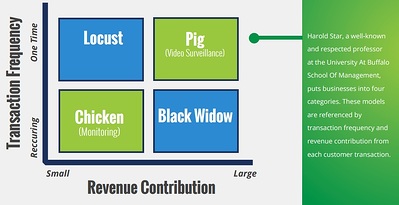The set-up, operation and overall success of your business can depend greatly on the type of business model adopted at the onset. Choosing a business model for your business requires understanding and planning of type of operation you want to run and how you plan to produce profits.
According to investopedia, a business model is the plan implemented by a company to generate revenue and make profits from its everyday operations.
Will you operate as a manufacturer of goods, a distributor, a retailer or will you add additional opportunity and grow as a franchise business?
Business Model Goal: Generate Profits and Growth
The main aim of starting a business is to increase profits by growing the revenue and decreasing the costs associated with the running of the business. In our related e-book, “How Chickens Can Transform Your Business,” we discuss many of the important lessons to learn when evaluating your options and determining what model will generate the best results. With this in mind, the e-book states,
“a fundamental principle when measuring the value of the business is the extent to which it can generate profitable revenue which is repeat and recurring from its customers. Choosing a business model for your enterprise therefore determines the success or failure of your business.”
Factors to Consider When Choosing a Business Model
Carefully consider these five factors when evaluating business model options and developing your plan for the growth of your business.
1) Scalability
The idea of scalability is this: Increased output does not always require increased input. When choosing a business model for a new venture, successful entrepreneurs always consider scalability. Scalability involves growing revenue on one hand, while maintaining or decreasing costs as you grow. One example is when sales increase, this does not necessarily require a business to increase the number of its employees.
Highly scalable enterprises are not weighed down by the relationship between the growth of sales and costs that are involved. As sales increase, you should ensure that your costs remain fairly flat for higher profits to be realized over time. Automation of business processes, especially in the production phase, results in the decrease of costs associated with higher sales. This can be done by investing in software that lightens the employee load, instead of solely relying on human capital.
2) The Value Offered
Business models are built on customer value. The more value you provide your customers, the more value they will return to you. When choosing a business model, you have to consider why the customers will choose your products over other businesses products. What is unique about your produce? How will you make your customers feel appreciated and special? As explained in our related e-book, “How Chickens Can Transform Your Business,” an organization can create profits by focusing on 1) transaction frequency, 2) revenue contribution, or 3) both.
Review the image below to see the relationship between these factors.

Source: Chickens
If you’re able develop a business model with products at a perceived reasonable cost and high transaction frequency, your enterprise will enjoy a lot of recurring revenue, characterized by the “chicken” analogy, yielding lots of eggs! This eventually leads to a very solid business venture.
3) The Market Potential
Customers are the biggest asset in any business venture. It is always good for you to analyze how big the market will be for your idea. Big markets always promise stable and predictable monthly revenue. It therefore becomes imperative to consider the customer base when looking at the different business models. Some of the questions you need to ask to evaluate your product’s market include:
- Who will pay for this product/service?
- Who has bought the product in the past?
- What feedback has come from my professional network?
- What feedback has come from customized consumer research?
- Who are my competitors and what is the potential to gain market share?
4) Competitors
Speaking of competitors, it is always good to consider what others in the same line of business are doing. You should always aim to gain a competitive advantage over other competing organizations. This can be achieved by creating products with more desirable features, better performance, providing higher customer service and delight and marketing the product at lower prices.
5) The Ideal Customer
When starting or running an enterprise, you have to consider the very specific characteristics and qualities of the customers you are going to serve. Customer tastes and preferences are always changing. It’s well known that it is easier to maintain the customers that you already have (existing customers) than it is to find new customers. If the customers are treated well, they are likely to assist you in marketing your products through social sharing, word-of-mouth and viral marketing.
Embracing Lessons From the Farmer
Using the factors above to review your goals, your potential and the business environment, you can wisely implement the business model that will bring your desired level of success. Remember, choosing your ideal business model should be based on a rationale of how your organization captures, creates and adds value, while also supporting the values, mission and goals of your organization.
Find out all the “business lessons from the farmer” in the e-book referenced in this post, shown below. With this resource, you can find out which revenue steams are available and ideal for your unique business — and how to start collecting all those recurring revenue “eggs!”

